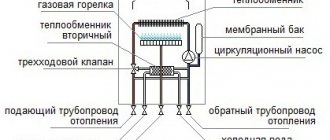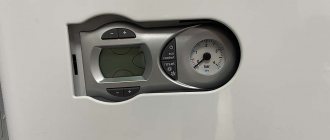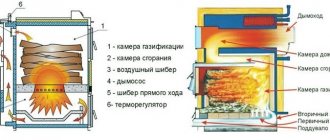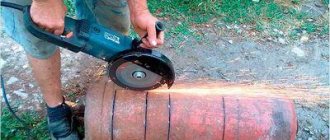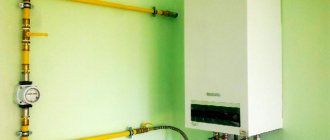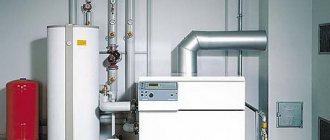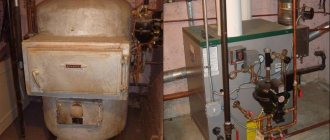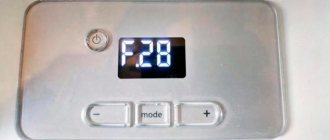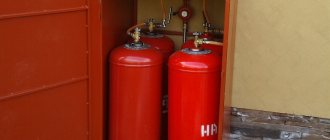The use of even relatively clean water as a heating fluid leads to clogging over time, not to mention untreated, contaminated coolant. The boiler heat exchanger is the first to suffer from clogging and scale. Precipitation on its walls narrows the cross-section of the pipe and the thermal conductivity of the metal, which affects not only the heating system, but also the operation of the boiler, which has to operate at increased power levels.
In the article we will look at how internal and external cleaning of the heat exchanger of a gas boiler is carried out. The process is not particularly difficult and can be done independently, without the involvement of specialists.
What is a heat exchanger?
The heat exchanger is an important component of a gas boiler.
Its main function is to transfer heat from a heated element to a secondary one. There are several types of heat exchangers:
- Primary. Structurally, they represent a coil made of a pipe equipped with fins to increase efficiency. When gas burns, heat is released which heats the heat exchanger and the liquid circulating through it. If the boiler is single-circuit, then only the primary heat exchanger is installed in it.
- Secondary (DHW heat exchangers) - installed in double-circuit heating boilers. A process similar to that mentioned above occurs, only the liquid heated to the required temperature serves as an energy source.
Secondary plate heat exchanger for hot water supply for Baxi boiler
Combined or bithermic heat exchangers. In many modern double-circuit heating boilers, bithermic heat exchangers are installed, which combine two heat exchangers in one design: for heating and for hot water supply (DHW).
Appearance of a bithermal heat exchanger. Designed for heating water in the heating circuit and for domestic hot water supply
A bithermal heat exchanger is also called a dual heat exchanger. The section shows that structurally it represents a “pipe within a pipe.”
Water from the hot water supply system flows through the inner pipe, and coolant from the heating system flows through the outer pipe.
Possible methods
There are two ways to flush the heat exchanger of a gas boiler:
- Mechanical
. To implement this cleaning method, you have to remove the heat exchanger and clean it yourself. Both operations are quite complex and require significant labor costs. In addition, the effectiveness of mechanical flushing is always inferior to chemical flushing. - Chemical
. This method allows you to do without removing the heat exchanger. A booster is required for chemical flushing of the heat exchanger.
You can make a booster yourself:
- A washing solution is poured into a container with a volume of about 15-20 liters;
- Next, hoses connected to the heat exchanger pipes are inserted into this container;
- The boiler is started, brought to a temperature of about 50 degrees and maintained in this state;
- The assembled structure is complemented by a circulation pump, thanks to which the solution for flushing the boiler from scale moves through the heat exchanger;
- It is advisable to install a filter on the supply hose that will not allow solid impurities to pass through the circuit.
The best option for chemical flushing is a reversible pump, but if you don't have one, you can change the location of the hoses to switch the system. Before starting the flushing equipment, the pressure in the system must be lowered to zero, the coolant must be drained from the heat exchanger, and the filter built into the boiler must be cleaned.
Double-circuit boilers with bimetallic heat exchangers are usually cleaned using a booster, i.e. chemically. If a separate stainless steel heat exchanger is used to heat hot water, it will need to be removed and cleaned separately. In order for the part to be properly cleaned, it should be boiled in water with a diluted washing solution.
Before cleaning, you need to find out how to clean a gas boiler from scale. The most common remedy is regular citric acid. As a rule, 20 g of acid per 1 liter of water is taken for a solution, but in some situations the concentration can be increased. For greater reliability, you can simply buy special products that allow you to effectively clean the heat exchanger and do not in any way affect the durability of the structural elements.
After completing cleaning using a booster, you need to pump purified water through the heat exchanger so that the solution does not remain in the system. After cleaning, the entire structure is assembled to its original state, and the boiler can be started.
Neutralization
When you are finally done flushing your boiler or heat exchanger, you will need to neutralize the flushing solution. To do this, stock up on regular soda.
And then there are two options.
Or you pour all the flushing solution into a separate container, call the Ministry of Emergency Situations, and they take the solution to a solid waste landfill (just kidding). Or you start adding a little soda to the intermediate tank. The pump is still running. The soda will react with the acid, fizz, and neutralize the latter. At the same time, you measure the pH, and as soon as it reaches 6-7 units (neutral), this solution can be poured into the sewer. It is advisable, in this case, to add cold water to the intermediate tank and drain the solution with a temperature of less than 50°C. These are the regulatory requirements of one of the RD (guidance document) dedicated to chemical washing. By the way, you need to find this document...
How often should the heat exchanger be flushed?
The cleaning frequency is specified by the equipment manufacturer in the operating instructions. For example, heat exchangers in Neva boilers must be descaled every 12 months.
The concentration of alkaline earth salts in water can vary. If the concentration is high, the water is called hard. When using it, scale forms faster, therefore, unscheduled cleaning may be required. Also, the rate of deposit formation depends on the thermal conditions and intensity of the boiler operation.
The presence of scale in the heat exchanger pipes and soot on its fins is indicated by a decrease in the heating performance of the equipment. To determine whether the actual heating output corresponds to that stated in the documentation, measure the temperature and composition of the flue gases using a gas analyzer.
In the absence of a device, the presence of scale can be judged by indirect signs: a decrease in the temperature and pressure of water leaving the boiler. If there is normal water pressure in the water heater pipeline, and a thin stream flows from the tap, check for deposits on the internal surfaces of the heat exchanger tubes.
Insufficient water heating at standard gas flow and normal pressure also indicates contamination of the heat exchanger.
Note that malfunctions in the operation of complex equipment can be caused by various reasons and the presence of scale is only one of the options.
Contact a professional or do it yourself
Professional cleaning of heating boilers is an expensive proposition. Depending on the condition of the equipment and the specifics of its operation, amounts can range from several tens to hundreds of dollars. In addition, the masters rarely arrive within the next few hours; sometimes you have to wait for them for several days. It is not comfortable.
The cost of professional cleaning using a special station for washing heat exchangers pays off: the parts are washed from the inside to a shine, and the equipment works much better. But if you want, you can always save money and do the same thing yourself. The result will be no worse, and you will only have to invest your own time and effort.
Professional device for washing heat exchangers
Basic washing methods
We should start with the fact that the heat exchanger is, first of all, a pipe system with liquid moving inside. But the water used in the systems is usually not of high quality. Various metal salts present in it settle on the walls of the structure, become scale and narrow the passage. There are three ways to deal with scale:
- mechanical;
- chemical;
- by pumping liquid into the system under strong pressure.
The article only discusses cleaning with your own hands, and therefore we will not talk about the third method. You definitely can’t handle it alone, since you will need a special compressor capable of creating a pressure of about 10 atmospheres. Only with the help of this device can deposits on iron surfaces be broken down.
Note! The other two methods can be handled with your own hands. Let’s say right away that this is quite difficult, and the appropriate skills will be required.
Video - Cleaning heat exchangers
https://youtube.com/watch?v=Ljjkd_IrQQg
Method number 1. Mechanical flushing
If this flushing of the gas boiler heat exchanger is used, do not forget that the exchanger itself takes up a lot of space in the heat generator. It is located above the combustion chamber, so it is not easy to get there. The algorithm of actions should be as follows.
Step one. The upper part of the housing is removed. To do this, you must turn off the electrical power and gas supply (if all this is provided for by the boiler design).
Step two. The exchanger is disconnected from the heating main.
Step three. The fixtures of the device are removed.
After this, you can remove the heat exchanger from the heat generator and proceed directly to the washing procedure. What can you see after dismantling? As a rule, all internal cavities are clogged with scale - metal salts, calcium or sodium, as well as trivalent ferum.
For cleaning you will have to use metal tools - pins, scrapers, etc.
During work, special care should be taken so as not to damage the surfaces of the structure.
In some cases, the device is wetted in a container filled with a weak solution of hydrochloric acid. And as soon as the scale softens, you can begin to remove it. At the end of the procedure, all internal voids are washed with water under low pressure. For these purposes, you can attach a hose connected to the water supply system.
You can see for yourself how much dirt will spill out. You need to wait until clean water starts flowing. Additionally, you can tap the surfaces of the device with a mallet (this is a special hammer made of wood or rubber).
Complete instructions for flushing a gas boiler
Previously, we talked about how to completely rinse and clean a gas boiler with your own hands, we advise you to read this information
Method number 2. Chemical washing
Let us immediately make a reservation that such washing is a rather complicated procedure. During the work you will need a special device called a booster. And, despite the fact that this option is extremely simplified, to implement it you should still be aware of a number of important nuances.
What is the simplification of the technique? First of all, there is no need to remove the heat exchanger and dismantle some elements of the gas boiler. You just need to disconnect a couple of pipes (a special hose needs to be connected to one of them, through which the cleaning agent will be supplied inside the housing). Having passed through the body, the product will come out through the second pipe, to which a hose will also be connected. Consequently, both in the exchanger and in the booster, the funds will move in a circle.
Now let’s look at what components the booster itself consists of. These include:
- chemical container;
- an electric heater (not all models have it, but people with experience advise purchasing just such models; this way the reagent will heat up, and being warm, it removes salt and dirt deposits more quickly and efficiently);
- pump.
Note! Such chemical reagents can be various kinds of solutions that are freely available on the domestic market. And the question of choosing the right reagent is the most pressing
In each specific case, it is necessary to take into account not only the degree of clogging, but also its type, as well as the material used in the manufacture of the heat exchanger.
Next, we will find out by what means the heat exchanger of a gas boiler can be flushed.
Stove with heat exchanger for a bath
Previously, we talked about how to choose a good stove with a heat exchanger for a bath, we advise you to read this information
How to clean the heat exchanger?
The heat exchanger is cleaned at the end of the heating season. To carry out the work, it is enough to have a standard set of tools. Before starting work, it is necessary to disconnect the boiler unit from the gas network (main or local) and electricity.
Let's look at how to clean a floor-standing gas boiler
:
- first of all, the burner device is dismantled;
- it is necessary to disconnect all wires from the gas valve;
- a thermocouple is removed from the combustion chamber and connected to the gas valve by a capillary tube;
- the fuel supply pipe is disconnected;
- the bolts or nuts (4 pcs) securing the stove with the burner are unscrewed, the assembly is removed out.
It is convenient to clean the gas boiler burner with an old toothbrush. Soot must also be removed from the flame control sensor, igniter, and piezoelectric device for automatic ignition.
To get to the boiler heat exchanger, remove the top cover of the unit, disconnect the draft sensor and chimney, remove the insulation, dismantle the casing fasteners and the casing itself. Having gained access to the heat exchanger, it is necessary to remove the turbulators from it.
A soft metal brush is suitable for cleaning turbulators, and the heat exchanger itself is freed from soot deposits with a miniature scraper made of thin metal. A brush with a long handle is also used. First of all, the smoke pipes are cleaned and swept, then the soot that has fallen off on the bottom should be removed.
Cleaning the wall-mounted boiler is done with a toothbrush.
Cleaning a wall-mounted heat generator. After turning off the gas supply, it is necessary to dismantle the front panel of the boiler. Then the front cover is unscrewed, which closes the combustion chamber. It is recommended to cover the nozzles with a sheet of thick paper to prevent the burner from becoming clogged by falling soot. Do-it-yourself cleaning of the heat exchanger of a double-circuit boiler is done using an old toothbrush or a brush with metal bristles. After cleaning is completed, you need to sweep the heat exchanger with a brush and carefully remove the paper with the collected soot. See the video below to see how the procedure is performed.
Flushing a single-circuit and double-circuit gas boiler
Flushing the heat exchanger of a gas boiler is necessary to remove internal deposits that can disrupt the normal circulation of the coolant in the heating system and cause problems with the supply of hot water to the local hot water system. Also, deposits may contain substances that destroy metal.
How often this activity needs to be performed depends on the type of coolant. If purified water circulates in the system, it is enough to carry out preventive maintenance once every four years, removing deposits. A system with antifreeze should be flushed every two years and the coolant should be changed regularly - under the influence of high temperatures, it changes properties over time and can become dangerous for the metal elements of the system.
Final works
The heat exchanger is put back into the boiler only after it is completely dry. You can't wipe it off. To speed up the process, you can use a warm air stream from a hairdryer. Installation of the heat exchanger is performed in the reverse order.
After the heat exchanger is put back into the boiler and connected to the temperature sensor, the boiler must be turned on to check the quality of the maintenance work performed. It is especially important to find out how quickly the heat exchanger will warm up.
Having understood the structure of the boiler during maintenance work, replacing the heat exchanger in a gas boiler with your own hands will not be difficult.
Advice. When the heat exchanger is removed from the boiler for the first time, it is advisable to film the disassembly process and take a photo. Then it will be much easier to collect all this.
Features of washing plate heat exchangers
In this case, the exchanger still needs to be disconnected from the boiler and the external and internal surfaces must be cleaned of scale. It's easiest to start cleaning from the outside. First, the device is filled with warm water, to which some household anti-scale, rust, and so on agent has been added. After some time, the product is washed off from the surface with clean water. It is most convenient to carry out this operation outdoors, using a car wash that supplies high-pressure water for washing. In the absence of such a wash, you can ask car wash workers to carry out this operation, but do not forget that too much pressure can damage the plates.
After cleaning the outer surface, you can wash the inner walls of the structure (these are the walls of the curved pipe). This flushing of the gas boiler heat exchanger is different in that there may be a fairly thick layer of scale on the surfaces, especially if the previous cleaning was carried out quite a long time ago, or was not carried out at all, or if hard water is used in the system. Even dirt can end up inside, getting there along with the working fluid, especially in the absence of a cleaning filter.
Video - Cleaning procedure for plate exchangers
Why is it necessary to flush the heat exchanger?
Essentially, a heat exchanger is a metal (or cast iron) box in which a radiator is installed. This radiator is heated by the fire of a burner located outside and gives off heat to the working fluid circulating inside.
In the case of a clean heat exchanger, it will function with maximum efficiency, and almost all the energy received will be used for heating. But over time, the walls of the internal channels become covered with various kinds of impurities - salts dissolved in the liquid (scale). Typically, scale forms especially actively in the secondary exchanger of the boiler for 2 circuits if hard water circulates in the network.
The consequences of this kind of pollution can be the most unpleasant.
- The heat exchanger is overheating. In accordance with the operating diagram of gas equipment, the coolant supplied from the return pipeline must cool the internal surfaces of the heating element. And if scale forms, the heat exchanger overheats and the device, as a result, fails.
- The efficiency of the heating device decreases. Mineral deposits are known to have a fairly low thermal conductivity, which means more energy is required to heat the fluid. Consequently, fuel consumption increases.
- Heating equipment breaks down. Due to mineral scale on surfaces, the movement of the working fluid is difficult. This places an excessive load on the circulation pump, which, as a result, quickly exhausts its working life (in the absence of timely cleaning of narrowed passages).
As you can see, if you flush the heat exchanger in a timely manner, you can not only save a lot of money, but also prevent the failure of expensive elements. In addition, a minimum of gas consumption is ensured.
Definition
A heat exchanger is a mechanism that directs heat from one coolant (water) to a second (air).
It contains special components and cavities.
If it is exposed to hard water for a long time, then scale, rust and other contaminants form in it. They need to be eliminated promptly.
The regularity of cleaning is determined by the quality of the water and the parameters of the boiler itself, as well as the degree of load on it.
Whatever washing method is chosen, first of all, deposits are removed using mixtures of different acids or special reagents. This is followed by rinsing with water.
If you do not carry out these operations, then:
- The heat exchanger will overheat.
- The efficiency of the boiler will decrease.
- The boiler may break down. In an advanced case, an explosion is not ruled out.
Popular cleaning methods
There are several technologies for washing heat exchangers, which can be divided into two groups: dismountable and non-dismountable. The dismountable washing method involves removing the heat exchanger from the gas boiler and washing it separately. When using disassembly-in-place technology, nothing needs to be removed, and the cleaning process is carried out using special equipment. Let's take a closer look at the main washing methods:
Manual cleaning
Manual flushing is of the collapsible type and requires disconnecting the heat exchanger from the gas boiler. Its body is cleaned of external contaminants with metal brushes and soaked for several hours in an acid solution or a special washing liquid. The main disadvantages of this technology are the lack of circulation of the reagent during the washing process and the harmful effects of reagents on gaskets and other sealing joints. When starting a flushed gas boiler, you should make sure that all connections are tight and that there are no leaks under pressure.
Chemical washing
Chemical (hydrochemical) flushing can be performed without dismantling the heat exchanger from the gas boiler. To remove rust, scale and other deposits, the heater is connected to a special device called a booster. This special device, equipped with a pump, pumps a chemical reagent through a heat exchanger in various directions for several hours. During this time, the chemistry included in the washing liquid completely removes the most complex contaminants without damaging the metal.
Hydrodynamic cleaning
This cleaning method also applies to in-place methods. Its essence lies in the fact that by connecting a special installation, water under high pressure is driven through the heat exchanger. Sometimes, to achieve a better result, the aqueous solution contains an abrasive filler. The increased speed of movement of the flushing fluid helps to effectively remove deposits from the walls of the heat exchanger.
Most often, owners of gas boilers use chemical flushing of the heat exchanger using a booster. To do this, they enter into an agreement with a company that performs this type of work, or purchase special equipment and do the cleaning themselves.
Briefly about the main thing
Every owner of an apartment or house with an individual heating system should understand that the appearance of scale on the heat exchanger is extremely dangerous. At first, it will hit your pocket every month with increased gas bills. Afterwards, the boiler may completely fail.
The problem must be solved, either independently or with the help of specialists. You can perform mechanical cleaning on your own; it is recommended to do it every year. Also, if you have a booster or similar equipment, you can perform dry cleaning.
If these two methods do not help, then the experts will tell you how to flush the heat exchanger. They will carry out hydrodynamic cleaning of the heating system and quickly remove even large accumulations.
Ratings 0
Cleanable nodes
Gas boiler installation. (Click to enlarge)
This type of equipment contains the following components that need to be cleaned periodically:
- igniter;
- burner with nozzles;
- gas filter;
- heat exchanger;
- firebox;
- chimney.
It is worth noting that cleaning each component of a gas boiler has its own specifics, which we will dwell on in more detail.
Igniter
The cleaning procedure occurs in the following sequence:
- shut off the gas supply to the boiler;
- unscrew the igniter;
- Clean thoroughly using a wire brush;
- perform purging;
- Reinstall the cleaned igniter.
Burner with nozzles
The sequence for cleaning the burner with nozzles is as follows:
the gas supply valve closes; the burner is removed from its installation location; the location of the nozzle is noted, and then it is carefully unscrewed; You need to carefully clean the nozzle with a brush; the burner is cleaned with a brush, and its hole is purged using available pumping equipment; the nozzle is inserted into the burner according to the mark; the burner is installed in place.
Expert advice: cleaning the burner with nozzles should be done once a year, preferably before the heating season.
Therefore, it is very important to regularly clean the filter from accumulated clogging.
Heat exchanger
It is also necessary to understand that this element of the boiler unit can become clogged both inside and outside.
The outer part of the heat exchanger becomes contaminated with soot, which negatively affects its functioning. This boiler unit can be cleaned of soot mechanically, in other words, cleaning is done with your own hands.
To do this you will need the following set of tools:
- scrapers;
- metal brush;
- various shapes of brushes;
- power tool with cleaning attachments.
The cleaning procedure is as follows:
- gas supply and power supply from the boiler is turned off;
- the heat exchanger is carefully removed;
- cleaning is carried out using convenient tools;
- the device is installed again in its place.
An important point: try to use a tool for cleaning that does not have sharp edges. Otherwise, you may cause damage to the heat exchanger, which may cause corrosion of the product in the future.
Here
As a result, the throughput of the heat exchanger decreases, which generally affects the functioning of the entire gas boiler. The most optimal way to clean the inside is to flush the gas boiler heat exchanger using chemicals.
Among the reagents that are used to clean the internal walls, the following products can be distinguished:
- adipic acid;
- sulfamic acid solution;
- special gel.
Specialist's note: the choice of reagent for flushing should depend only on the degree of contamination of the heat exchanger.
The booster consists of the following elements:
- circulation pump;
- reagent container;
- electric heater.
The principle of cleaning the heat exchanger using a flushing device such as a booster is as follows:
- to improve cleaning properties, the reagent is heated in a container;
- Using a pump, the solution is supplied under pressure directly to the heat exchanger.
As a result of the circulation of the chemical, the scale lags behind the internal walls and comes out along with the waste solution.
Experts advise: using a booster, you can clean not only the circuit of hot water boilers, but also the pipes of the entire heating system.
Firebox and chimney
Therefore, it is recommended to carefully monitor the formation of soot and regularly clean the chimney and firebox. We hope that the information presented in the article will be useful to you when cleaning your gas boiler.
Watch the video, which shows in detail how to properly clean a gas boiler at home:
Why is gas boiler flushing necessary?
To understand the importance of grounding the boiler, you just need to look at the diagram of its structure. The device is attached to the wall or installed on the floor, both options do not contribute to electrical conductivity. The pipes are usually composed of the non-conducting propylene
The pipes are usually composed of the non-conducting propylene
The device is attached to the wall or installed on the floor, both options do not contribute to electrical conductivity. The pipes are typically made from the non-conducting material propylene.
It becomes clear that static electricity finds no other outlet than a radiator in which water is concentrated.
As a result, being an excellent heat transfer agent, water also becomes an electrical conductor. With the onset of winter, the temperature of the equipment rises and the liquid is unable to remove the current charge. As a result, the operation of the gas boiler becomes unsafe.
What is the best way to wash the device?
Now let's figure out what is best to use for washing
Despite the fact that there are quite a lot of recommendations and instructions, the choice of a specific liquid should be treated with extreme caution. Most experts advise using saline solution for this purpose.
This solution really effectively removes growths, but by its nature it is quite aggressive. Consequently, there may be a risk of destruction of the internal surfaces of the structure.
Note! In addition, there is information that the use of hydrochloric acid can lead to brittleness of the metal. But citric acid, as it turns out, is not so dangerous for heating equipment
It copes well with various types of scale – no less effectively than today’s popular reagents, including “Sanax”, “Sillit”, “Detex” and others
And if you promptly and, more importantly, competently care for all elements of the heating system, you can not only increase its performance, but also significantly extend its service life. Cleaning the heat exchanger - one of the most important operations, as we have already found out - will be a significant contribution to this process
But citric acid, as it turns out, is not so dangerous for heating equipment. It copes well with various types of scale – no less effectively than today’s popular reagents, including “Sanax”, “Sillit”, “Detex” and others
And if you promptly and, more importantly, competently care for all elements of the heating system, you can not only increase its performance, but also significantly extend its service life. Cleaning the heat exchanger - one of the most important operations, as we have already found out - will be a significant contribution to this process
Cleaning the heat exchanger mechanically
Having removed the heat exchanger, you can begin cleaning it mechanically. Of course, you can choose the second option (using chemically active substances), but it will be described below.
Having gone through the removal process step by step and taking the heat exchanger out, users are presented with an unattractive picture: a large amount of deposits and soot both inside the pipes and between the cooling plates. The mechanical cleaning method involves the use of a metal cable with a brush at the end, as well as various scrapers and blades. Using this tool, harmful deposits are removed from both internal and external surfaces.
The outer surface of the heat exchanger can be cleaned using a hard bristle toothbrush.
To make the process of removing dirt faster, you can “soak” the device in water with the addition of detergents. Then plaque or scale will be removed much easier and without effort. When using a cable, it must be slowly pushed into the device, while turning it clockwise.
Using a metal brush on a rod when cleaning a floor-standing boiler
Steel brush with a diameter of 40 mm and a working surface length of 100 mm
After the inside is cleaned, you need to rinse the heat exchanger using a hose that can be connected to a centralized water supply. It doesn’t require a lot of pressure; even an ordinary stream of water is enough to wash away dirt, plaque and other deposits.
Contamination from the outer surface, especially between the blades, should be removed carefully, as this can lead to damage to the heat exchanger and disruption of its operation.
Soot on external surfaces
When gas is incompletely burned, soot, an amorphous allotrope of carbon, deposits on the outer surfaces of the heat exchanger. The heat exchangers of boilers with an open combustion chamber and natural draft suffer more from soot.
One of the reasons for its increased formation is the dustiness of the air in the room from which the combustion air comes. A lot of dust is generated during construction work. If the construction site is located near the entrance of a coaxial chimney, the heat exchanger of the boiler with a closed chamber may also become dirty.
A coaxial chimney consists of an inner and outer pipe. One of them serves to remove combustion products, the other serves to supply air into the closed combustion chamber
Insufficient diameter, incorrect configuration, and blockages of the chimney lead to poor draft. If the draft is poor, the removal of combustion products becomes difficult, and they settle in the form of soot on the lower outer part of the heat exchanger.
Like scale, soot has low thermal conductivity and reduces the efficiency of heat exchange equipment, leads to accelerated wear, and shortens the time between repairs. The efficiency of a heat exchanger contaminated with soot and scale can decrease by 25% or more.
What will cleaning the boiler do?
Boiler cleaning is a regular and integral procedure that requires certain knowledge and skills. Salt deposits accumulate inside the heat exchanger, and soot and soot accumulate in the chimney channels and the chimney itself
Therefore, in order for the equipment to be in proper condition, it is important to clean all elements of the boiler
As a rule, full power will be required in the midst of winter, which leads to the risk of being left without heating, and urgent repairs and cleaning of the boiler will cost a significant amount. To avoid this situation, you need to periodically perform work on flushing the heating boiler. You can clean the heat exchanger of a gas boiler yourself, spending several hours.
Conclusions and useful video on the topic
The heat exchanger of a gas boiler can be easily washed at home without the use of professional equipment:
How to descale the secondary heat exchanger of a double-circuit boiler and what is needed for this:
Modern methods and means help to effectively combat scale and prevent its formation. The main thing is not to forget to periodically flush the heat exchanger so that the real characteristics of the gas boiler correspond to the passport indicators throughout its entire service life.
Tell us about how you washed the heat exchanger of your own gas boiler. Share the effective methods of removing mineral plaque that you know. Please leave comments in the form below, ask questions and post photos on the topic of the article.
Why clean the heat exchanger?
Copper or its alloys are usually used in the manufacture of coils. The choice of metal is not accidental: copper has good thermal conductivity. However, there is a drawback, which is the intensive formation of oxide deposits. It is impossible to remove it mechanically.
During operation of the boiler, the oxide layer becomes larger and larger, thereby reducing the thermal conductivity of the coil. The efficiency of gas equipment can decrease by 15-30 percent, and this is noticeable in winter. The outside of the heat exchanger is literally “sticky” with soot, and scale forms inside. If you don’t wash it, it can get to such a state that you have to think about how to change the heat exchanger on a gas boiler.
Gas service specialists recommend preventive cleaning of the heat exchanger once a year, but practice shows that it is enough to clean the heat exchanger once every 2-3 years to be sure of its readiness for the heating season.
Frequency of cleansing
Typically, maintenance periods are reflected in the passport of each model. However, these are indicative values. And they mean that the device will work in comfortable conditions. In practice, the heat exchanger needs to be washed more often.
The need for these operations arises when:
- There is a big difference in the calculated parameters of the unit from the values in its passport. Efficiency decreases and thermal energy consumption increases.
- According to the plan, the rubber seals of the heat exchanger are being changed.
- Very dense deposits appeared on its plates.
Causes of failure
A faulty gas boiler can cause a lot of trouble for its owner. Moreover, it is sometimes impossible to figure out the causes of the problem on your own. The list of possible faults is very wide.
When conducting diagnostics, make sure there is gas and electricity, and check water consumption. Does the unit continue to operate intermittently? Carefully inspect the internal and external structure to eliminate possible causes of technical problems.
The most common errors in the operation of gas boilers are considered to be program failures. In such cases, experts advise analyzing the control panel for possible damage. You can also carry out independent adjustment of the device and configure the boiler according to the operating rules.
If, after searching for visible causes of the malfunction, the boiler continues to heat poorly, and you have not found the reason for the poor operation of the device, we can safely say that the unit is covered with foam from chemical compounds and this interferes with its full functioning.
See also: Basic requirements for installing a gas boiler (more details here)
Flushing heat exchangers
Carrying out scheduled flushing of the plate heat exchanger allows you to increase the performance of heating, water supply, air conditioning and ventilation systems. The technology is quite simple and includes the following sequential steps:
- Connection of the flushing pump.
- Preparing a reagent solution and bringing it to the required concentration.
- Putting the pump into operation in accordance with operating requirements.
- Check effectiveness by monitoring pH and gas emissions.
- Thorough flushing of the heat exchanger.
- Neutralization and disposal of used chemical liquids.
- Pump shutdown.
If the service has been carried out in full accordance with the requirements, the heat exchangers will regain their original properties and will be ready for efficient operation.
As practice shows, poorly maintained plate heat exchangers are contaminated with scale, rust, silt and various types of organic contaminants by 50 percent or more, which inevitably leads to a significant decrease in thermal efficiency and the amount of heat transferred from the coolant to the heated medium.
The operating principle of a plate heat exchanger is to transfer thermal energy from hot to cold coolant through a heat exchange surface made of corrugated metal plates.
Flushing of the heat exchanger is carried out by employees of certified Ridan Service Partners, or by specially trained personnel of the operating organization in accordance with the operating manual supplied with the device.
Why shouldn't you postpone flushing the heat exchanger?
If you ignore the fact that the heat exchanger does not produce the calculated parameters for too long, this leads to the following consequences:
- Increased fuel consumption
(more thermal energy is required to heat the environment); - An increase in hydraulic resistance
(contaminants in the heat exchanger channels slow down the movement of the coolant, which creates additional load on the pump and can lead to its breakdown); - Failure to provide the required parameters for coolant temperature,
“underheating,” which leads to a decrease in the quality of heat supply to consumers or a decrease in the cooling efficiency of the primary circuit coolant; - Overestimation of the temperature of the primary circuit coolant
leaving the heat exchanger.
With regular cleaning and maintenance of the heat exchanger, your equipment will last a long time and operate at maximum efficiency throughout its entire service life.
Flushing technology
The heat exchanger must be cleaned after the end of the heating season. For the job, the usual tools that any owner has will be quite sufficient. Immediately before cleaning the coil of a gas boiler, the equipment must be disconnected from the gas main (or from the cylinder, if bottled gas is used as fuel) and the electrical network.
Cleaning the heat exchanger of a floor-standing gas boiler is carried out as follows:
- First of all, you need to remove the gas burner;
- Then you need to disconnect all the wires going to the gas valve;
- A thermocouple connected to the gas valve via a capillary tube must be removed from the combustion chamber;
- Next, the gas supply pipe is turned off;
- Lastly, you need to unscrew the fastenings of the stove with the burner and remove the entire element from the boiler.

